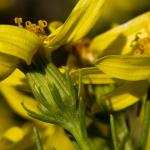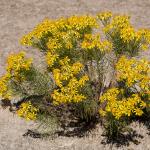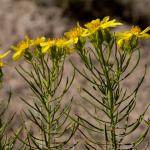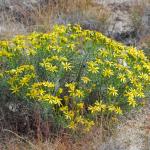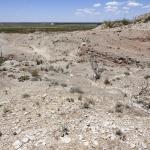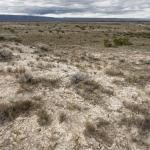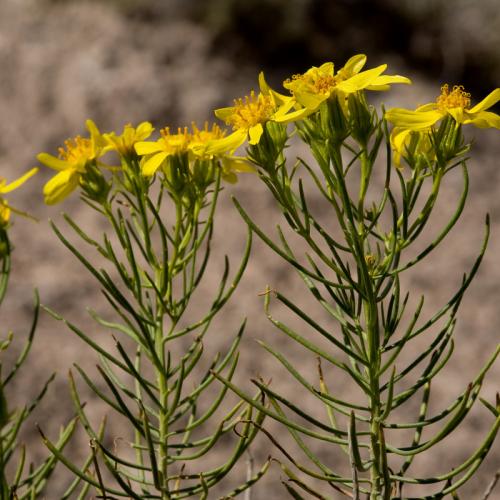Senecio warnockii (Warnock's ragwort)
Family
ASTERACEAE
Synonyms
NONE
Common Name
Warnock's ragwort
| USFWS | State of NM | USFS | BLM | Navajo Nation | State Rank | Global Rank | R-E-D Code | NMRPTC Status | Strategy Status |
|---|---|---|---|---|---|---|---|---|---|
| S2 | G3Q | 1-2-2 | R | SS |
| Overall Conservation Status | Documented Threats | Actions Needed |
|---|---|---|
| WEAKLY CONSERVED | No information |
Status surveys on abundance, distribution and threats |
Description
Hemispherical subshrubs, 20-40 cm high, with many straight, generally unbranched, stems from a woody base; unevenly woolly-tomentose on stems and leaves, older growth sometimes becoming glabrous; leaves alternate, linear or filiform, 2-7 cm long and ca. 1 mm wide, crowded in the distal half or so of the stems; heads in flat-topped inflorescences, radiate; ca. 13 erect phyllaries in one series, 5-8 mm long, glabrous or very sparsely tomentose; phyllaries on most or all heads subtended by 3-8 ascending bracts (the calyculus) 1/5 to 1/2 the length of the phyllaries; ray florets ca. 8, yellow; disk florets 15-25, yellow; fruits (cypselae) cylindrical, glabrous, with a pappus of capillary bristles. Flowering August to October; probably also April and May in wet years.
Similar Species
There are three other shrubby ragworts in the general area: Senecio flaccidus var. flaccidus, Senecio riddellii, and Senecio spartioides. These are distinguished from Senecio warnockii as follows:
Senecio flaccidus var. flaccidus is 40-120+ cm high (vs. 20-40 cm); has leaves evenly distributed, not succulent, seldom recurved, sometimes pinnatifid (vs. crowded distally, thick & somewhat succulent, often recurved, never pinnatifid); bractlets of the calyculi minute or 0 (vs. well-developed on most or all heads); cypselae pubescent (vs. glabrous).
Senecio riddelli has glabrous stems and leaves (vs. woolly-tomentose); at least the proximal leaves pinnatifid (vs. never pinnatifid); cypselae pubescent (vs. glabrous).
Senecio spartioides usually has glabrous stems and leaves (vs. woolly-tomentose); the proximal leaves often pinnatifid (vs. never pinnatifid); calyculus absent or minute (vs. well-developed on most or all heads); phyllaries usually 8 (vs. usually 13); ray florets usually 5 per head (vs. usually 8).
Distribution
New Mexico: Otero County (Alkali Lakes) and Eddy County (Yeso Hills and Seven Rivers Hills). Texas: Culberson and Hudspeth counties, as far south as Clayton Draw north of the Apache Mountains.
Habitat
Gypseous clay, usually sparsely vegetated, with Yucca elata, Sartwellia flaveriae, Thelesperma megapotamicum, Tiquilia hispidissima, Nerisyrenia linearifolia, Ephedra torreyana, Mentzelia humilis var. humilis, Bouteloua breviseta, and Sporobolus nealleyi.
Remarks
Although Senecio warnockii is morphologically and ecologically distinctive, the taxonomy of the shrubby ragworts is somewhat unsettled and needs further research. Shinners (1964) thought Senecio warnockii was most closely related to, and possibly a variant of, Senecio spartioides. Ediger (1970) concluded that it is merely a gypsophilic phase of Senecio flaccidus (which he recognized under the name Senecio douglasii. Barkley (2006) recognizes it as a distinct species, but suggests that additional research might show it to be a form of Senecio flaccidus. Barring new information to the contrary, we are following the work of Barkley and believe Senecio warnockii is a good species.
Conservation Considerations
This is a narrowly distributed and ecologically specialized species, but seems to be reasonably common within those limits. Herbicide applications to remove shrubs have been conducted in and near this plant's habitat in New Mexico. Oil and gas development has impacted some of its habitat on the east side of the Guadalupe and Delaware Mountains in both New Mexico and Texas. So far, a relatively small portion of Senecio warnockii's habitat is affected by these activities, but if continued or expanded in scope they could become significant threats. Large-scale gypsum mining is a minor potential threat. This species is probably toxic to livestock, like most Senecio, and not likely to be directly threatened by livestock grazing.
Important Literature
Barkley, T.M. 2006. Senecio. Pp. 544-567 in Flora of North America North of Mexico vol. 20, ed. Flora of North America Committee. New York and Oxford.
Ediger, R.I. 1970. Revision of section Suffruticosi of the genus Senecio (Compositae). Sida 3:504-524.
Shinners, L.H. 1964. New names and records for Texas Compositae. Sida 1:373-379.
Information Compiled By
Patrick Alexander 2017
For distribution maps and more information, visit Natural Heritage New Mexico


